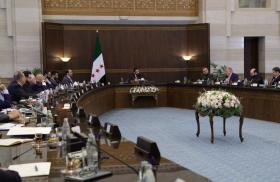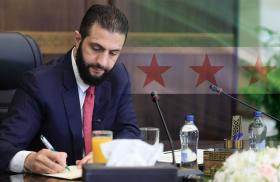
- Policy Analysis
- PolicyWatch 4046
Nuclear Talks and Iran’s Missile Program: Addressing the Overlooked Arsenal

Given Iran’s unchecked missile buildup since the last nuclear deal, any future agreement should include enforceable limits on the development and stockpiling of long-range missiles to ensure lasting regional security and nonproliferation.
During negotiations for the 2015 Joint Comprehensive Plan of Action (JCPOA), the United States and other countries made numerous efforts to incorporate limits on Iran’s nuclear-capable ballistic missiles. In the end, however, the agreement remained focused on nuclear activities, leaving the missile program largely untouched. The perils of this omission have become glaringly evident in recent years and could further darken the security and nonproliferation picture in the Middle East—and beyond—if a new deal takes the same approach.
What the Previous Deal Left Out
The JCPOA imposed no direct, verifiable limits on Iran’s ballistic or cruise missiles, and the related UN Security Council Resolution 2231 (2015) only “called upon” Tehran not to develop ballistic missiles designed to deliver nuclear weapons for eight years without the council’s permission. The resolution did attempt to close some of the loopholes by referring to a U.S. letter (S/2015/546), but it used ambiguous and nonbinding language, especially compared to previous UN resolutions such as 1929, which banned such activity (see PolicyWatch 3246). In any case, Iran never endorsed any of the relevant resolutions prior to 2231.
The JCPOA bought time but failed to address the very systems that could one day carry nuclear warheads. The voluntary limitations of Resolution 2231 expired in October 2023, removing any international checks (however symbolic) on Iran’s missile program. The nuclear deal’s narrow scope, while politically expedient in 2015, left a missile-sized loophole in the world’s nonproliferation efforts.
Iran’s Expanding Nuclear-Capable Missile Arsenal
The regime accelerated its missile program and stockpiling efforts after the JCPOA went into effect. Although some sanctions on these activities remained in place, Iran tested dozens of new and upgraded ballistic missiles that showed improved range, accuracy, and survivability. With some modifications, many of those missiles would be capable of carrying custom-designed nuclear warheads. Iran has also considerably improved the survivability of its largely dispersed missile force with hardened underground bases. In fact, Brig. Gen. Amir Ali Hajizadeh, commander of the Islamic Revolutionary Guard Corps Aerospace Force, claimed—perhaps hyperbolically—that the IRGC operates up to 100 large underground bases. (Independent observers place that number between 25 and 50.)
Today, Iran possesses the Middle East’s largest ballistic missile arsenal—over 3,000 according to U.S. estimates. These include medium-range systems (long-range in Iranian parlance) capable of reaching Israel, the entire Arabian Peninsula, and southeastern Europe, and shorter-range missiles that cover the Persian Gulf region, including U.S. bases there. Iran has also advanced in solid-propellant technology (enabling quicker launches) and harder-to-intercept missiles that use hypersonic velocities, maneuvering warheads, decoys, and penetration aids. And it has used large, multistage, solid-propellant rockets to launch satellites—an achievement that has crossover potential for intermediate-range and intercontinental ballistic missiles.
Iran has expanded its cruise missile capabilities as well, and they now occupy a key part of its arsenal. Since 2015, the regime has unveiled at least six new long-range cruise missile types with ranges between 700 and 1,650 km. These low-flying weapons are harder to detect than ballistic missiles and more difficult to intercept. In 2023, Iran introduced a boosted hypersonic cruise missile with a claimed range of 1,500 km. When it completes testing and enters service, it will provide survivable precision-strike capability well beyond Iran’s borders.
International concerns about what the regime might do with these capabilities are hardly hypothetical. Since 2017, Iran has directly launched hundreds of ballistic and cruise missiles of various types in at least nine major operations targeting adversaries in Syria, Iraq, Pakistan, Israel, and Saudi Arabia, while its proxy forces have also used hundreds of Iranian-origin missiles. These strikes have served dual purposes—retribution and strategic signaling—with Tehran seemingly hoping (sometimes in vain) that its strikes would deter adversaries from attacking its territory.
In essence, this strategy for proliferating and using missiles has turned regional conflicts into testing grounds, enabling Iran to continually refine its capabilities. Well-documented missile (and drone) transfers to Russia and proxies such as Hezbollah in Lebanon, the Houthis in Yemen, and militias in Iraq and Syria were designed to entrench Tehran’s regional influence and allow it to impose costs on adversaries without direct confrontation. Moreover, the precision-guidance technologies that are increasingly part of proxy arsenals illustrate how Iranian advances are exported in parallel with domestic development. (Notably, proxies have not yet implemented these precision capabilities very effectively.) In Russia’s case, weapons transfers enabled Iran to indirectly influence developments in Europe and make substantial financial gains in the process.
How to Integrate Missiles into a New Deal
Iran’s capabilities, combined with its ideological and geopolitical intentions, make missile restrictions essential in any future deal. Any U.S.-negotiated agreement that addresses only nuclear materials and facilities without addressing the requisite delivery systems is insufficient. Although introducing this element would be diplomatically difficult, ignoring it again would raise even more formidable national security difficulties down the road. Accordingly, U.S. negotiators should prioritize the missile issue by focusing on three areas.
First, the lapsed UN restrictions should be renewed and strengthened, and new limitations should be put in place to verifiably ban all testing, development, and technology transfers related to nuclear-capable ballistic and long-range cruise missiles, as defined by existing international nonproliferation regimes. This would create a benchmark based on clearer pre-2015 UN language and eliminate the ambiguity that Iran has repeatedly exploited.
The Missile Technology Control Regime (MTCR) offers a well-established baseline of a 300 km range and 500 kg payload for a nuclear-capable missile. Missiles under that limit are deemed tactical; those exceeding it are intended to strike strategic targets, potentially with a nuclear warhead. MTCR-conforming missiles are sufficient for Iran’s legitimate defensive needs. Hence, if Tehran’s intentions are truly defensive, it should be willing to formalize this cap in combination with region-wide de-escalation and major reposturing. This threshold reflects not only a technical benchmark, but also an intent-based boundary between a defensive and offensive military orientation. As for verification measures, the Intermediate-Range Nuclear Forces (INF) Treaty of 1987 can be a useful model.
Second, missile-related moratoriums and export controls must be tied to nuclear deal incentives. Sanctions relief should hinge on Iran halting the development, testing, and transfer of missiles and long-range, one-way attack drones above the MTCR threshold, with verifiable elimination. Linking compliance to tangible gains raises the cost of defiance and incentivizes negotiation. A UN-led monitoring mechanism should oversee missile transfers, backed by a technical body combining experts from the MTCR, the UN Office for Disarmament Affairs, and the UN Institute for Disarmament Research under a Security Council mandate. Past arms-control regimes have demonstrated the efficacy of such monitoring mechanisms when properly resourced and politically backed.
Previous treaties and codes of conduct also offer great lessons on other key elements such as declarations of inventories/sites, onsite inspections, remote monitoring, satellite tracking, telemetry sharing, and pre-launch notification.
Third, during or after bilateral talks with Iran, Washington should ask its partners to initiate a regional missile dialogue with Tehran. Gulf Arab states and Israel—Iran’s direct targets—must have input. A regional pact could include test notifications, deployment limits, and a halt on transfers to nonstate actors. Framing these steps as components of a regional security package—not unilateral disarmament—may make it more acceptable to Iranian leaders. Tehran has repeatedly called for regional dialogue and should be pressed to give substance to that rhetoric.
Conclusion
Long-range missiles and attack drones are central to Iran’s threat posture, and ignoring them again puts U.S. negotiators at risk of concluding a flawed agreement that removes the threat posed by high-enriched uranium production but enables Tehran to expand and advance dangerous delivery systems, which it has proven more than willing to use and proliferate in recent years. Iran often portrays its missiles as symbols of legitimacy, strategic influence, “resistance,” and “divine justice,” cultivating this narrative through years of propaganda and distorted facts. The aura created around the subject is intended to shield the program from international scrutiny and domestic accountability and criticism, and it has been successful thus far. Breaking that cycle requires bold outreach that aims to not only impose limits, but also dismantle myths. The majority of Iranians know that Tehran’s depiction of the United States and Israel as threats to the Islamic Republic is a function of the regime’s own misplaced strategic choices, driven mainly by ideological posturing and false narratives.
A balanced solution would cap Iran’s nuclear threat and constrain its missile reach, while allowing retention of shorter-range systems (i.e., sub 300 km) for legitimate defense. Without missile limits, any “new JCPOA” will have the same major flaw as the previous one. It is time to close the missile loophole and secure a more comprehensive deal, which could open the way for meaningful regional dialogue in the future. Indeed, a new agreement that includes long-range missiles would be a step toward redefining regional stability in the twenty-first century, reassuring U.S. allies, upholding nonproliferation norms, and pushing Iran toward a more transparent, less destabilizing strategic posture.
Farzin Nadimi is a senior fellow at The Washington Institute, specializing in the security and defense affairs of Iran and the Persian Gulf region.



